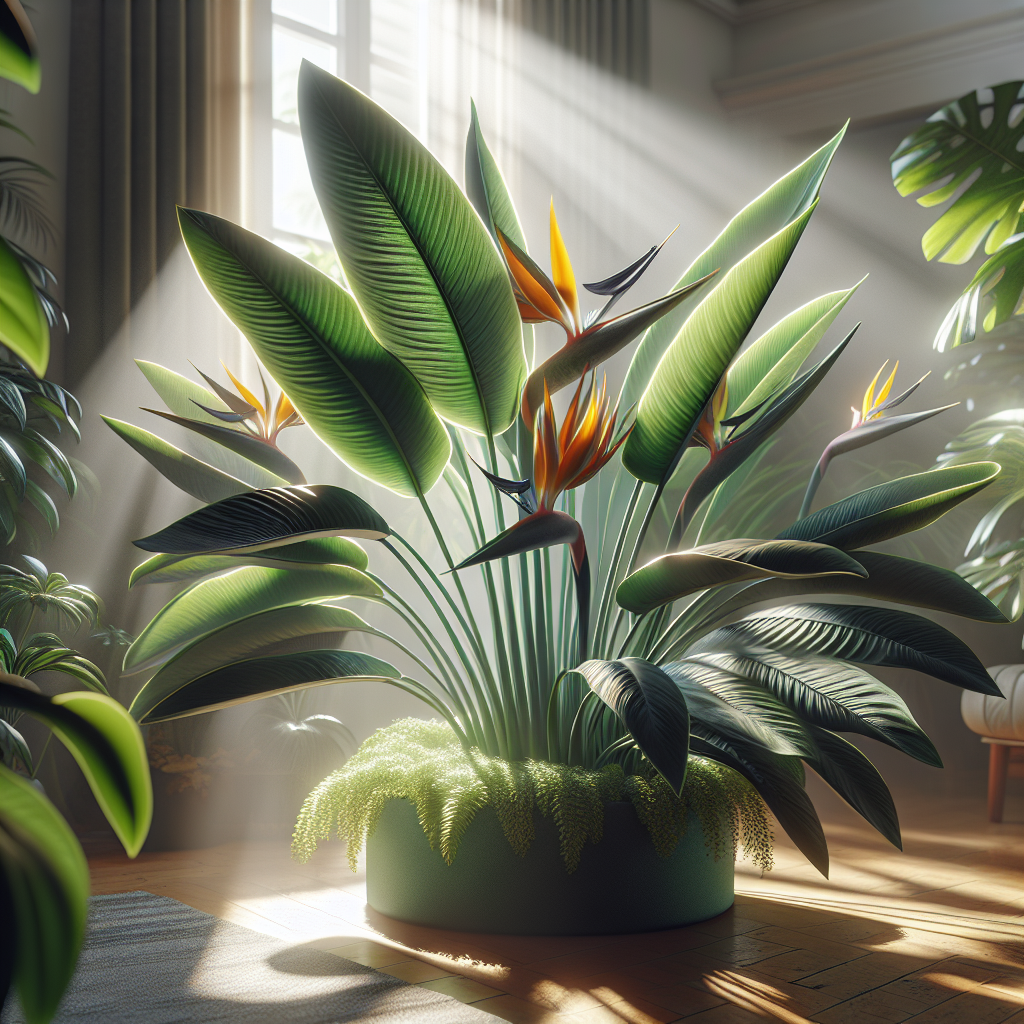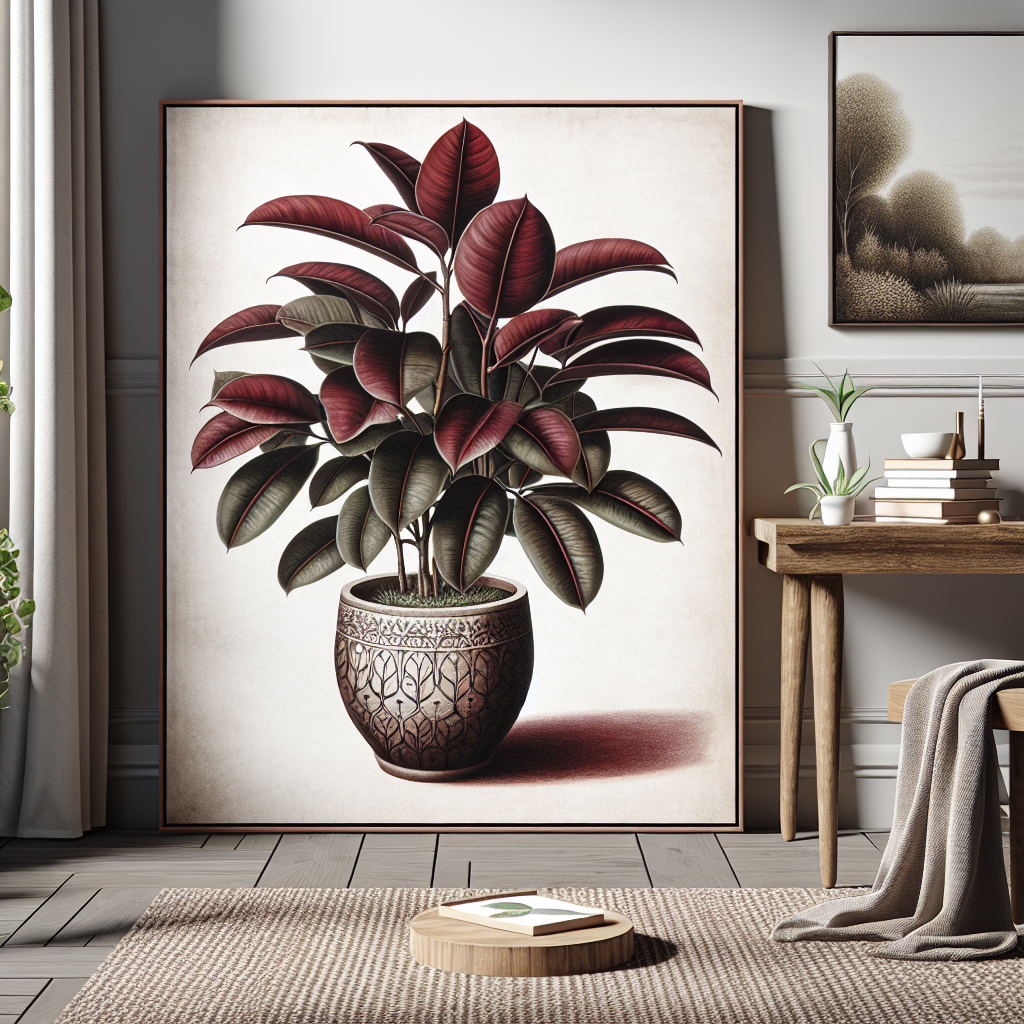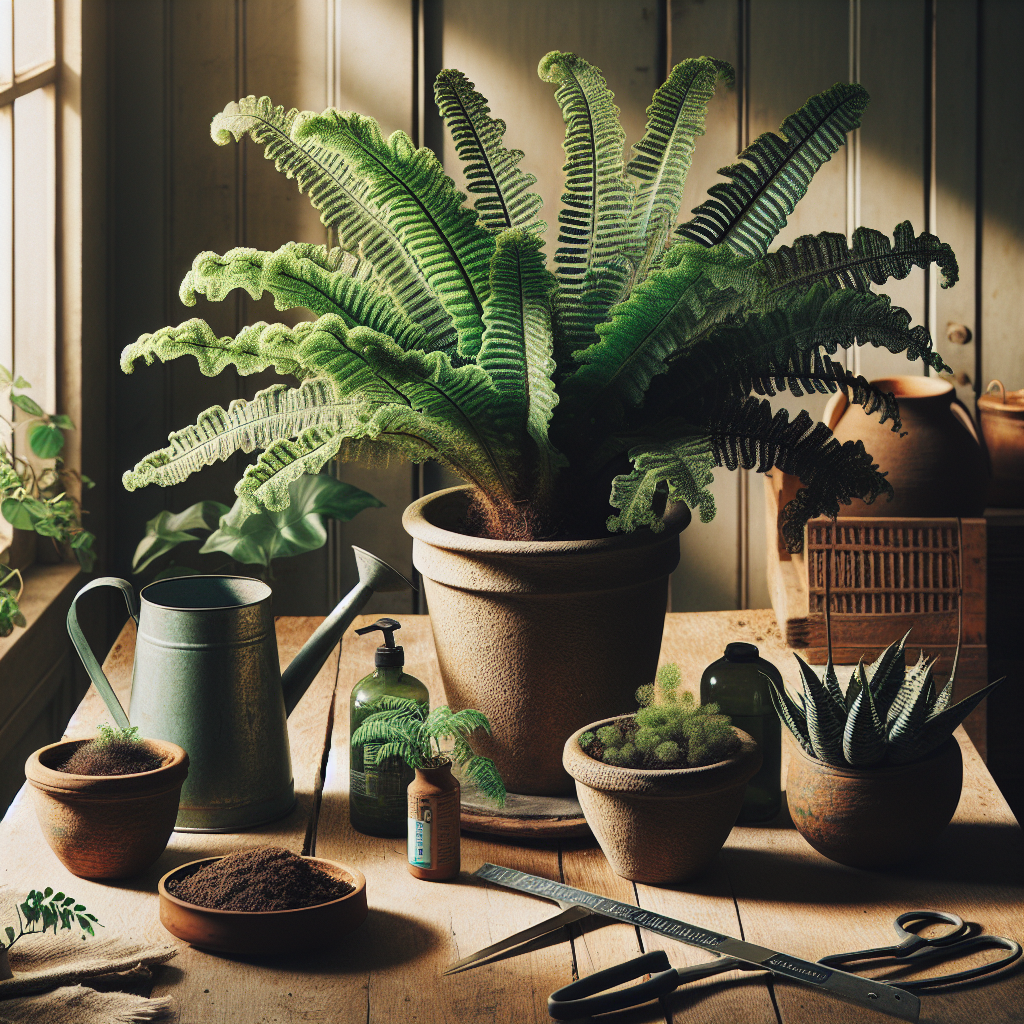Indoor Bird of Paradise: A Guide to Lush Foliage
Published January 5, 2024 at 7:33 am

Indoor Bird of Paradise: Optimal Growing Conditions
- Pet Friendly
The Bird of Paradise, while lush and beautiful, is not pet-friendly. It contains toxins that can be harmful if ingested by pets. Always keep this plant out of reach of curious cats and dogs to prevent any accidents.
- Light Requirements
This tropical plant thrives in bright, indirect sunlight. A spot near a south-facing window where the sunlight is diffused by sheer curtains would be ideal. Avoid direct sunlight that can scorch its leaves.
- Watering
Water when the top inch of soil feels dry to the touch, which typically translates to once a week. Consistency is key—keep the soil evenly moist but not waterlogged to prevent root rot.
- Humidity
Being a tropical plant, the Bird of Paradise enjoys high humidity. A regular misting or placing a humidifier nearby can mimic its natural humid environment.
- Temperature
Aim for a temperature range of 65-75°F (18-24°C). Avoid sudden temperature drops and cold drafts as they can damage the plant.
- Difficulty
This plant is moderately easy to care for, making it suitable for gardeners with some experience. It requires attention to its environmental needs but is quite resilient once established.
Choosing the Right Soil for Your Indoor Bird of Paradise
Your Bird of Paradise will thrive in rich, well-draining soil that allows roots to take up moisture without sitting in water. A popular choice among plant enthusiasts is a mix specifically designed for tropical plants. These mixes often include peat, pine bark, and perlite—which provide the perfect balance of drainage and water retention.
If you look for a commercial soil mix, FoxFarm Ocean Forest Potting Soil is a top contender. It has a mix of earthworm castings, sea-going fish and crab meal, and bat guano, among other high-quality organic ingredients. It provides a light, aerated texture that this plant loves.
Reviewers often rave about the boost in their plants’ growth after repotting with FoxFarm soil. It seems to be well-received by a variety of plants, not just the Bird of Paradise. However, some mention that because of its nutrient richness, you should monitor your plants for signs of over-fertilization.
Pros
- High-quality, organic ingredients
- Good water retention yet drains well
- Includes mycorrhizae and other beneficial microbes
Cons
- Pricier than some other soil mixes
- May be too nutrient-rich for some sensitive plants
Find This and More on Amazon
When and How to Repot Your Bird of Paradise
As a fast-growing plant, the Bird of Paradise may need to be repotted every couple of years. The best time is during the spring or early summer when the plant is in its active growth phase. Choose a pot that is a couple of inches larger in diameter than the current one to give your plant room to expand.
When repotting, gently loosen the roots and remove any dead or rotting roots. Add fresh soil to your new pot, ensuring that there is a layer of drainage such as gravel or pebbles at the bottom.
The sleek and minimalist design of LE TAUCI Ceramic Plant Pots make them a stylistically versatile choice. These pots have been lauded for their quality and chic appearance, providing a substantial base for top-heavy plants like the Bird of Paradise. The built-in drainage system is another benefit that users appreciate, as it keeps the soil environment optimal for root growth.
Pros
- Sleek and modern design that fits in with most decor
- Comes with a drainage hole and saucer for excess water
- Durable, high-quality ceramic
Cons
- As with most ceramic pots, they can be heavy and fragile
- Slightly higher price point than plastic alternatives
Find This and More on Amazon
How to Address Common Issues: Yellowing Leaves
A common issue with indoor Bird of Paradise plants is yellowing leaves. This can occur for several reasons such as overwatering, insufficient light, or a nutrient deficiency. If overwatering is the culprit, cut back on your watering schedule and make sure your pot has adequate drainage.
If light is the issue, consider rearranging your space to allow more natural light, or invest in a grow light. The Roleadro LED Grow Light is a good option based on what people have said—users share that their indoor plants, including the Bird of Paradise, respond well to the full spectrum light provided, and they appreciate the light’s energy efficiency.
Pros
- Energy-efficient LED technology
- Provides full spectrum light suitable for various growth stages
Cons
- Some users may find it cumbersome to install
- The fan may be a bit noisy for some people’s liking
Find This and More on Amazon
Understanding Watering Techniques for Your Bird of Paradise
Getting the watering just right for your Bird of Paradise can be tricky. The key is not to let the plant sit in water, as its roots are prone to rotting if they’re too damp. This means that while your watering routine might be somewhat consistent, it’s crucial to adjust according to seasons and the plant’s growth cycle.
During the growing seasons of spring and summer, you might find that your plant requires more frequent watering—as often as once a week. But when the cooler months roll in, your Bird of Paradise will slow its growth, and its watering needs will diminish. This is a time when vigilance is vital because the soil tends to retain moisture for longer, increasing the risk of root rot.
A moisture meter might come in handy to take the guesswork out of when to water. For example, the XLUX Soil Moisture Meter has a simple interface that provides an accurate moisture level reading. Taking reviews into account, people find it straightforward to use, with the easy-to-read dial being a favorite feature, allowing them to ensure their Bird of Paradise gets the perfect amount of water.
Pros
- Easy to read and use
- No batteries required
- Helps prevent over and under-watering
Cons
- Can break if inserted into very hard soil with force
- Not suitable for use in potting mix with high perlite content
Find This and More on Amazon
Balancing Humidity for Healthy Growth
One of the more challenging aspects of caring for a Bird of Paradise indoors is providing adequate humidity. Tropical plants, by nature, need moisture in the air to thrive and this is often higher than what our homes naturally provide. You might notice that leaves becoming brown and crispy at the edges when the air is too dry.
A classic solution is regular misting. However, to maintain the consistency that the Bird of Paradise craves without the maintenance, consider investing in a humidifier. The Pure Enrichment MistAire Ultrasonic Cool Mist Humidifier is often mentioned in reviews as being ideal for plant owners. Its ultrasonic cool mist quietly adds moisture to the air, helping to create the kind of environment a tropical plant would enjoy.
Pros
- Quiet operation
- Can run for up to 16 hours on a single fill
- Small footprint and unobtrusive design
Cons
- Requires regular cleaning to prevent mold growth
- Some users report a shorter life span than expected
Find This and More on Amazon
Fertilizing Your Indoor Bird of Paradise
To foster lush, healthy growth, your Bird of Paradise will benefit from regular fertilization. During its active growing season from spring to summer, a balanced liquid fertilizer can be applied about once a month. Look for fertilizers that offer a balance of nitrogen, phosphorus, and potassium, which are essential for the plant’s overall health and foliage development.
An example of a well-rounded plant food suited for the Bird of Paradise is the Miracle-Gro Indoor Plant Food. This product receives praise for its ease of use and the visible difference in plant condition and growth post-application. Its pump dispenser allows for a simple, mess-free application – a plus point mentioned in various reviews.
Pros
- Easy to use with its pump design
- Can be used for all your indoor plants
- Feeds instantly
Cons
- Over-fertilization can lead to salt build-up in the soil
- Not organic, may not be suitable for all gardeners’ preferences
Find This and More on Amazon
How to Encourage Flowering in Indoor Bird of Paradise
While the Bird of Paradise is primarily grown for its substantial, textured foliage indoors, getting it to flower can be a real treat. Though indoor plants don’t bloom as readily as those grown in their natural habitat, creating the perfect environment can sometimes lead to flower production.
To encourage your Bird of Paradise to bloom, ensure that it’s getting enough light. The plant typically needs a bit of maturity, at least 4-5 years, before it can produce flowers. Additionally, maintaining the proper temperature and feeding it with a phosphorus-rich fertilizer can promote flowering.
Rather than using a standard fertilizer, you might want to consider one specifically formulated for blooms, like the Jack’s Classic Blossom Booster Fertilizer. It’s acknowledged by users for improving the number and vibrancy of blooms on flowering plants. Its high phosphorus content is just what a Bird of Paradise requires to be coaxed into flowering.
Pros
- Formulated specifically for flowering plants
- Users report enhanced bloom size and quantity
- Water-soluble for easy application
Cons
- May not be as effective for foliage development
- Requires more careful application to prevent overfeeding
Find This and More on Amazon
Managing Pests and Diseases in Your Indoor Bird of Paradise
Like any houseplant, the Bird of Paradise can be susceptible to pests and diseases, which can hinder its growth and aesthetic appeal. Common pests include spider mites, mealybugs, and scale insects. These pesky critters enjoy sucking on the sap from the leaves, which can lead to yellowing leaves and stunted growth.
To control these pests, regular inspection of your plant is essential. You can remove mealybugs using a cotton swab dipped in alcohol, while a natural insecticidal soap can be effective against spider mites and scales. For an eco-friendly option, many plant enthusiasts recommend Neem oil. It’s a natural, non-toxic product that works well on various pests. A Neem oil solution like Garden Safe Brand Neem Oil Extract Concentrate gets the thumbs up for being easy to mix and apply, with users noting its effectiveness in getting rid of hard-to-beat pests without harmful chemicals.
Pros
- Eco-friendly and non-toxic
- Effective against a wide range of houseplant pests
- Acts as both a pesticide and a fungicide
Cons
- Has a strong smell that may not be pleasant to all users
- Requires consistent application to be effective
Find This and More on Amazon
The Aesthetic and Psychological Benefits of Growing an Indoor Bird of Paradise
Aside from its lush foliage and the potential for spectacular flowers, having an indoor Bird of Paradise can greatly enhance your living space both aesthetically and psychologically. Plants can be truly transformative in the home, acting not just as decor but also as natural air purifiers. It’s said that they contribute to reducing stress and boosting our mood, making them a worthwhile addition for both their beauty and wellness benefits.
The presence of greenery in your environment can also encourage a calming atmosphere and improve focus, which is particularly beneficial in work-from-home setups. Plus, the journey of nurturing a Bird of Paradise from a fledgling plant into a towering green companion can be incredibly rewarding, offering a sense of accomplishment and closeness to nature.
Creating the Perfect Environment for Your Indoor Bird of Paradise
To summarise, caring for an indoor Bird of Paradise involves a few key considerations, but with the right conditions, this plant can be a stunning, low-maintenance addition to your space. Always remember to provide bright, indirect light, consistent moisture without waterlogging, adequate humidity, and warm temperatures. Additionally, an annual repotting, pest control, and mindful fertilization will help ensure your plant remains healthy and vibrant.
If you’re looking to create that lush, tropical vibe in your home, the Bird of Paradise is the perfect plant to start with. With its grand stature and impressive leaves, it can make any corner of your room feel like an exotic oasis. All it needs from you is a little bit of care and understanding of its natural tropical needs. In return, it will grow tall and proud, making your indoor garden a focal point of beauty and natural charm.
Shop more on Amazon

